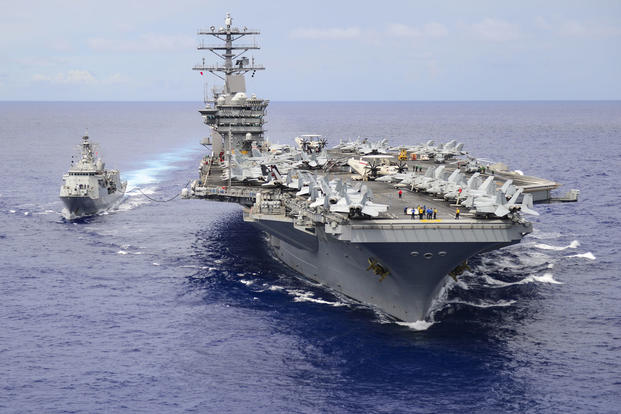The carrier Nimitz arrived in the Pacific on Tuesday, marking an exceedingly rare occurrence: three carriers and their attached strike groups operating together in the same region of the world.
The carrier convergence comes amid intensifying threats from North Korea and other moves from the Pentagon indicating preparations for a decisive military response.
The Nimitz entered the 7th Fleet area of operations following operations in support of the fight against the Islamic State in the Middle East. Since July 25, the Nimitz launched 1,322 sorties and dropped 903 pieces of ordnance, according to a news release from the 7th Fleet.
The Nimitz joins the carriers Theodore Roosevelt and Ronald Reagan in the Pacific. The Roosevelt entered the Pacific on Monday, and is eventually expected to take the place of the Nimitz in the 5th Fleet area of operations, covering the Middle East.
Related content:
- Second US Carrier Enters Western Pacific Amid North Korea Tensions
- Man Who Posed as Navy SEAL Convicted of Making Child Porn
- Navy Destroyer Howard Aids Iranian Fisherman After Pirate Attack
Fox News reported Roosevelt's arrival marked the first time since the 1990s that two carriers had been together near the Korean peninsula.
7th Fleet officials said the Nimitz strike group is next scheduled for a port visit, but would remain ready to support operations throughout the Pacific before returning to homeport.
Rear Adm. Gregory Harris, commander of Carrier Strike Group 11, said in a statement that the strike group had demonstrated dedication and commitment during its three-month airstrike mission in the Middle East.
"They performed flawlessly in extremely austere conditions, maintaining an incredible spirit that was awe-inspiring," he said. "I am eager to see what this team does in the next phase of our journey and welcome the opportunity to serve with such a fine group of sailors and Marines."
A Navy spokeswoman, Lt. Mary Walsh, characterized the carriers' activities as standard, and noted the Nimitz' presence in the region is temporary.
"It's not uncommon for two carrier strike groups to overlap when they're transiting from deployments," she said.
The convergence of carriers comes days after reports surfaced that the Air Force is preparing to place its fleet of nuclear B-52 bombers on 24-hour alert status, a defensive step that has not been taken since the Cold War.
Rhetoric has also been escalating. On Monday, Japanese Defense Minister Itsunori Onodera called the threat posed by North Korea "unprecedented, critical and imminent."
To date, North Korea has fired 22 missiles in 15 separate tests in calendar year 2017, most recently firing two missiles that flew over Japan on Aug. 29 and Sept. 15.
On July 4, North Korea test-fired an intercontinental ballistic missile.
Military leaders, including Chairman of the Joint Chiefs of Staff Gen. Joseph Dunford, have said publicly that the United States should assume North Korea has nuclear weapon capability and is willing to use it.
-- Hope Hodge Seck can be reached at hope.seck@military.com. Follow her on Twitter at @HopeSeck.
Related Video:
Want to know about the Nimitz-Class Carriers? Here are a couple quick bullet point facts.


























